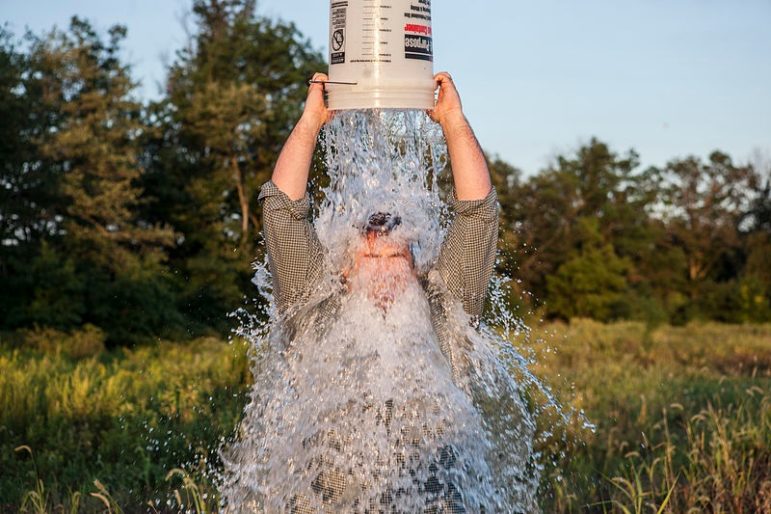
This August marks the two-year anniversary of the ubiquitous Ice Bucket Challenge, a viral campaign affiliated with the ALS (Amyotrophic Lateral Sclerosis) Association (ALSA). As NPQ readers—really anyone with access to a digital screen—will recall, the challenge charged its participants to dump a bucket of frigid ice water on their head and call out their friends to do the same, all while raising awareness and, ironically, dollars for ALS research. Ironic because the original challenge’s rules actually spelled out that the ice bucket was in fact an alternative to making a monetary donation to the organization. Because what’s colder than soaking oneself in ice water? Apparently, charitable giving.
What’s even more ironic is despite the massive volume of people who ostensibly opted for dousing rather than giving, the Ice Bucket Challenge resulted in an astoundingly successful fundraising year for the ALS Association. In 2014, the ALS Association saw 308,000 new donors and secured $115 million in gifts. Impressive for any organization’s standard calendar year, beyond extraordinary when it’s achieved in a six-week period, as was the case for the ALSA, thanks to the Ice Bucket Challenge.
Last week, AdWeek took a trip down memory lane, recapping the surprising success of the Ice Bucket Challenge and speculating whether the viral campaign will ever resurface to its original popularity. Carrie Munk, chief communications and marketing officer for ALSA, expressed her confidence in the public’s allegiance to the Ice Bucket Challenge, even two years after its rise to fame, telling AdWeek’s Molly Folse, “The real lasting effect of the Ice Bucket Challenge is now August is a time that people are thinking about ALS. They will always remember back to that crazy summer when the ALS Ice Bucket Challenge happened.”
But will they, really?
ALSA has made commendable effort to keep the awareness brought on by the Ice Bucket Challenge front and center, launching the #ChallengeALS campaign aimed at educating individuals on what more they can do to help further ALS research after they’ve dried off. It’s worth noting that in 2015, one year after the ice-cold phenomenon took over all social media feeds, ALSA did raise $1 million during the month of August, significantly less than the August before, but nonetheless a praiseworthy number by normal standards. So while those who participated in the Ice Bucket Challenge might remember that one crazy summer when they played a part in one of the most popular fundraising campaigns to ever hit the sector, their memories aren’t necessarily prompting renewed financial support, at least not at the same level as before.
Of the 2.6 million donors that contributed the record-breaking total in 2014, 23 percent gave ALSA permission to continue communications. The considerable dip from 2014 to 2015 in philanthropic revenue generated, coupled with the aforementioned example, perhaps represents the transactional nature of the campaign altogether. Like anything online that goes viral, there is a limited lifespan and eventually people’s attention will move onto the next trending topic. When a viral marketing approach is applied to a fundraising initiative and gains fast speed like the Ice Bucket Challenge did, it is undoubtedly difficult for an organization to maximize the opportunity to develop meaningful and long-lasting relationships with the gigantic influx of campaign donors.
Sign up for our free newsletters
Subscribe to NPQ's newsletters to have our top stories delivered directly to your inbox.
By signing up, you agree to our privacy policy and terms of use, and to receive messages from NPQ and our partners.
Of course, the folks at ALSA were smart enough to know that they needed to take the steps necessary to address the challenge of donor retention in this scenario. According to ALSA’s President and CEO Barb Newhouse, the organization is not resting on its laurels. “The ALS Association is working hard on the programs [the donors] have invested in and at the same time building our engagement of these new donors to keep them donors. The worst thing that can happen that in 3-5 years—we can’t sustain the research.”
But could the Ice Bucket Challenge, a sort of one-hit wonder, be the product of a much larger challenge the nonprofit sector is facing? Especially since the introduction of social media channels, well-intentioned individuals are becoming increasingly more likely to “support a cause” via liking, sharing, and posting online about their commitment to an organization instead of actually supporting the cause head-on via things like advocating, giving and volunteering.
The Ice Bucket Challenge is an appropriate example of this, wherein the flood of soaking wet supporters drew attention to their own participation in the campaign, but oftentimes gave little stage time to the importance of ALS research, some not even mentioning it all. As Will Oremus wrote in Slate during the height of the Ice Bucket Challenge: “More than anything else, the ice bucket videos feel like an exercise in raising awareness of one’s own zaniness, altruism, and/or attractiveness in a wet T-shirt.” This concept—coined by Emmanuel College research fellow William MacAskill as “donor-focused philanthropy”—takes the awareness away from the core issue at play and instead entertainingly shifts it toward the star of the viral video at that moment in time. In a 2014 piece for NPQ, Rick Cohen highlighted MacAskill’s views on this backwardness:
The ice bucket challenge is a symbol for much that’s wrong with contemporary charity: a celebration of good intentions without regard for good outcomes. It is iconic for what I call donor-focused philanthropy—making charitable giving about the giver, rather than about those who need help.
Because the idea for the Ice Bucket Challenge did not actually originate within the ALSA, the rapid acceleration of the campaign left the organization with no choice but to implement reactionary strategies in an effort to embrace all the good it brought to their cause. Although in the past year the campaign has not reached previous levels, Munk says the organization has prepared to be more prepared for those supporters wanting to make it an annual tradition. “We [had] the luxury of being able to plan for the campaign and not be 100 percent reactive,” Munk said.
While we shouldn’t be so quick to point fingers at those who mean well and for good reason, a phenomenon like the Ice Bucket Challenge will forever be a case study for marketing and fundraising professionals alike. When something goes viral, it reaches the masses at fast speed, which is good if you want to quickly communicate a message or call to action. It’s not so good if you’re looking to truly understand where your audience is coming from, what their motivations are and how they wish to engage with your organization in the long-run—vital ingredients in the recipe for effective fund development. Nevertheless, any engagement in an organization’s cause is better than no engagement at all. As Cohen aptly pointed out, “Does it matter whether [the] charitable giving is thoughtfully considered or simply the result of a fundraising gimmick? That’s the real core issue here.”—Lindsay Walker














